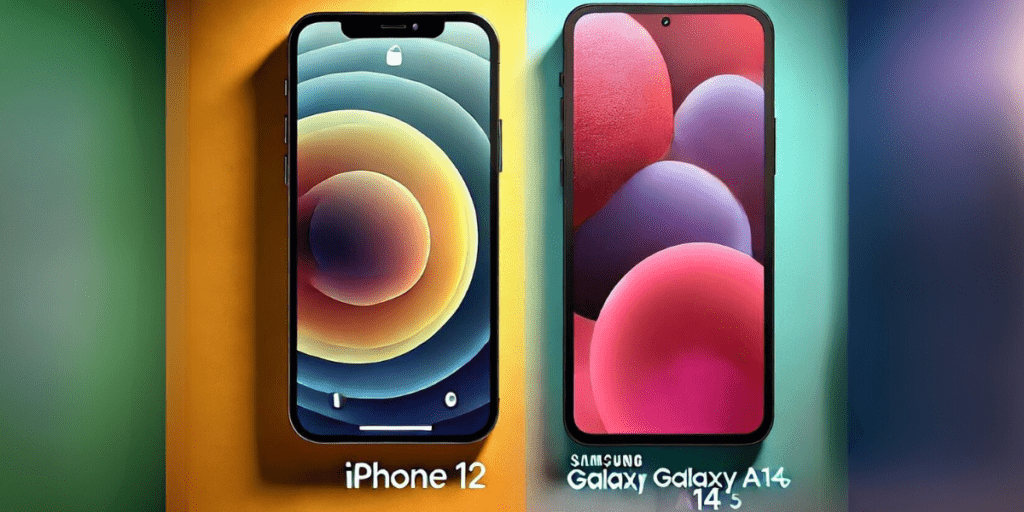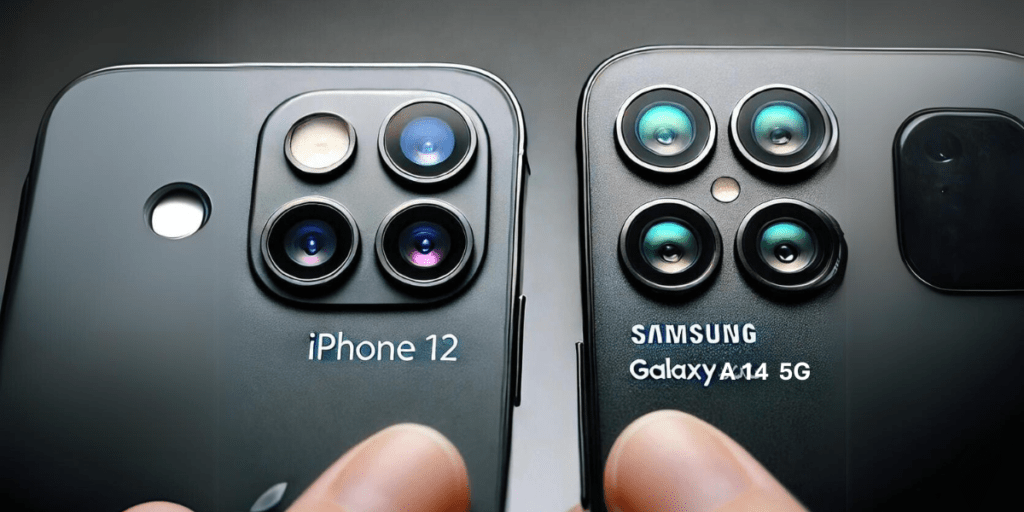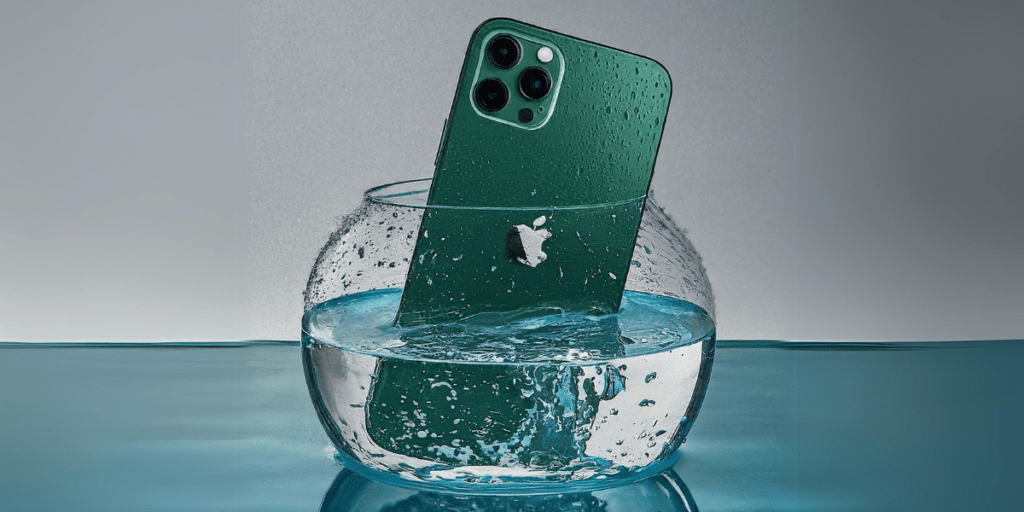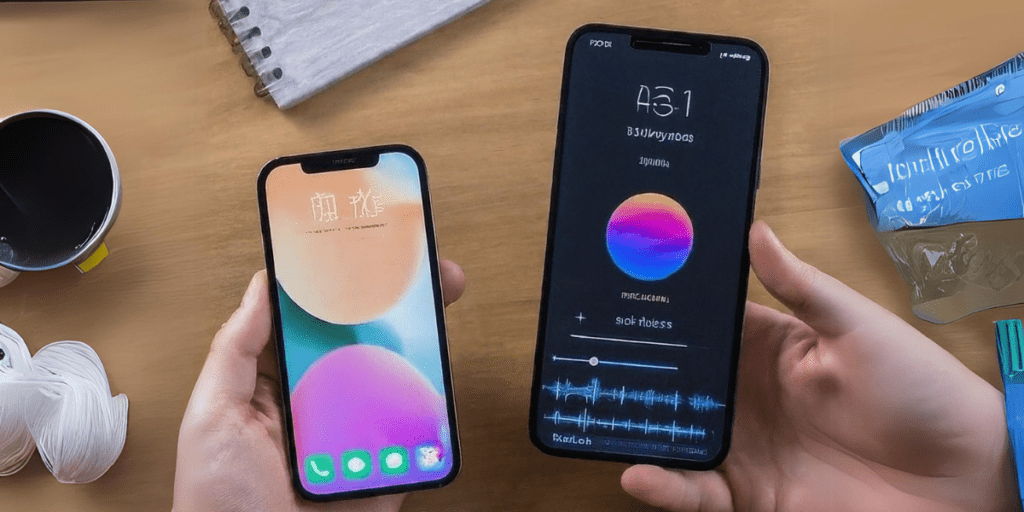Is the iPhone 12 better than the Samsung Galaxy A14 5G? In 2014, if you are considering one of these two phones to purchase, then you may be looking for this question. Both phones offer unique features and cater to different user needs.
The iPhone 12 is known for its sleek design and advanced technology, while the Samsung Galaxy A14 5G stands out with its affordability and impressive battery life. You need the right phone for your everyday tasks, entertainment, and communication. In this article, we’ll talk about the essential aspects of each phone, from design to performance. Let’s get started.
Which One Should You Choose: iPhone 12 or Samsung Galaxy A14 5G?

The answer is simple, with top-notch performance, the iPhone 12 is way ahead of the Samsung Galaxy A14 5G. But, let’s see which one matches your need –
The iPhone 12 is perfect for those who want a premium, long-lasting device. If you value excellent camera quality, a sharp display, and faster 5G speeds (including mmWave), the iPhone 12 offers a top-tier experience. It’s great for multitasking, gaming, and those who enjoy high-end features like MagSafe.
Meanwhile, the Samsung Galaxy A14 5G is a great option for budget-conscious users. It’s good for everyday tasks, browsing, and streaming. It also has a headphone jack and decent battery life, so it’s a good choice for practical users who don’t need the most advanced features.
Side-by-Side Comparison Table: iPhone 12 Vs Samsung Galaxy A14 5G
If you want to look at a quick comparison, here is the table covering all the features for both iPhone 12 & A14 5G. However, if you want to read further, you can go in later sections, and we have covered in detail discussion about these two phone specifications.
| Feature | iPhone 12 | Samsung Galaxy A14 5G |
| Release Date | October 2020 | January 2023 |
| Price at Launch | Starting at $799 | Starting at $199 |
| Display | 6.1″ Super Retina XDR OLED1170 x 2532 pixelsHDR10, Dolby Vision, True Tone | 6.6″ PLS LCD1080 x 2408 pixels90Hz refresh rate |
| Processor | Apple A14 Bionic (5nm)Hexa-core | MediaTek Dimensity 700 (7nm)Octa-core |
| RAM | 4GB LPDDR4X | 4GB / 6GB |
| Storage Options | 64GB / 128GB / 256GBNon-expandable | 64GB / 128GBExpandable via microSD up to 1TB |
| Rear Cameras | Dual Camera System:- 12MP Wide (f/1.6, OIS)- 12MP Ultra-wide (f/2.4)Features: Night Mode, Deep Fusion, Smart HDR 3 | Triple Camera Setup:- 50MP Main (f/1.8)- 2MP Macro (f/2.4)- 2MP Depth Sensor (f/2.4)Features: LED flash, Panorama |
| Front Camera | 12MP TrueDepth (f/2.2)Features: Night Mode, 4K video recording | 13MP (f/2.0) |
| Video Recording | Up to 4K@60fpsDolby Vision HDR recording | Up to 1080p@30fps |
| Battery Capacity | Approx. 2815 mAh | 5000 mAh |
| Charging | 20W Fast Charging (50% in 30 mins)MagSafe wireless charging (15W)Qi wireless charging (7.5W) | 15W Fast ChargingNo wireless charging |
| Operating System | iOS 14 (upgradable to latest iOS version) | Android 13 with One UI Core |
| Dimensions | 146.7 x 71.5 x 7.4 mm (5.78 x 2.82 x 0.29 inches) | 167.7 x 78.0 x 9.1 mm (6.60 x 3.07 x 0.36 inches) |
| Weight | 164 grams (5.78 oz) | 202 grams (7.13 oz) |
| Biometrics | Face ID (3D facial recognition) | Side-mounted fingerprint scanner |
| Water Resistance | IP68 (up to 6m for 30 mins) | None specified |
| Connectivity | 5G (Sub-6GHz and mmWave), Wi-Fi 6, Bluetooth 5.0, NFC, Lightning port | 5G, Wi-Fi 5, Bluetooth 5.2, NFC (region-dependent), USB-C port |
| Headphone Jack | No | Yes |
| Expandable Storage | No | Yes (microSD up to 1TB) |
| Colors Available | Black, White, (Product) Red, Green, Blue, Purple | Black, Light Green, Dark Red, Silver |
| Additional Features | MagSafe support, Dual SIM (nano-SIM and eSIM), Stereo speakers, Dolby Atmos support | Dual SIM (Nano + MicroSD), FM Radio, Dolby Atmos support |
| Battery Life | Video playback: Up to 17 hoursAudio playback: Up to 65 hours | Longer battery life due to larger capacity (varies based on usage) |
| Software Updates | Typically receives updates for 5+ years | Typically receives updates for 2-3 years |
| Audio | Stereo speakers | Mono speaker |
| Sensors | Accelerometer, Gyroscope, Proximity, Compass, Barometer | Accelerometer, Gyroscope, Proximity, Compass |
Design and Build Quality Breakdown: iPhone 12 Vs Galaxy 14 5G

Materials Used
The iPhone 12 and Samsung Galaxy A14 5G differ significantly in their construction. The iPhone 12 gives off a premium feeling with its glass front and back, covered in an aluminum frame. This combination not only looks elegant but also adds durability. On the other hand, the Samsung Galaxy A14 relies on plastic materials. So, it is more lightweight but less luxurious in feel.
Dimensions and Weight
When it comes to size, the iPhone 12 is compact and sleek, measuring 146.7 mm in height, 71.5 mm in width, and 7.4 mm in thickness. It weighs 164 grams, which is relatively light, so it is easy to handle. In contrast, the Galaxy A14 is larger and heftier at 167.7 mm tall, 78 mm wide, and 9.1 mm thick, weighing 202 grams. If you like a more substantial grip, this might be for you.
Water and Dust Resistance
The iPhone 12 stands out with its IP68 rating and provides excellent protection against dust and water. It can withstand being submerged up to six meters for 30 minutes, so it’s great for adventurers. However, the Galaxy A14 doesn’t have an IP rating, so it’s less suitable for harsh environments.
The iPhone 12 offers a more premium and durable design, but the Galaxy A14 is more budget-friendly and lightweight. Consider these differences based on your lifestyle needs and preferences.
Exploring Display Features: iPhone 12 Vs Galaxy 14 5G
Screen Size and Resolution
In terms of screen size, the Galaxy A14 wins with its 6.6-inch display. This larger screen is perfect for those who love big visuals. On the other hand, the iPhone 12 offers a 6.1-inch display, which is more compact but doesn’t compromise on quality.
The iPhone 12’s resolution is 2532 x 1170 pixels, which provides sharp and clear images. In comparison, the Galaxy A14 has a resolution of 2400 x 1080 pixels. Both phones offer impressive displays. But, of course, the iPhone 12’s resolution might give you a slightly crisper picture.
Pixel Density and Color Accuracy
Pixel density is an important factor that affects display quality. The iPhone 12 boasts a pixel density of 457 PPI, ensuring every detail is crystal clear. Meanwhile, the Galaxy A14 has a pixel density of 399 PPI, which is still quite good but not as sharp as the iPhone’s.
Color accuracy can make or break your viewing experience. The iPhone 12’s OLED screen shines with vibrant and accurate colors, while the Galaxy A14 uses an LCD screen. This means the iPhone will definitely deliver richer colors, especially noticeable in photos and videos.
Additional Features
Here’s where the iPhone 12 really stands out: it supports HDR, enhancing your viewing experience with greater contrast and brightness. Plus, its OLED technology ensures deep blacks and brighter whites. The Galaxy A14 offers a solid display but lacks HDR support, which might make a difference if you’re a movie buff.
So, if you’re after a vibrant and sharp display with HDR, the iPhone 12 is your go-to. However, if you prefer a larger screen and are okay with less sharpness, the Galaxy A14 might be your match.
Performance Showdown: iPhone 12 Vs Samsung Galaxy 14 5G

Let’s dive into the beating hearts of our devices.
Processor Power
The Apple iPhone 12 is powered by the A14 Bionic chip, which operates at a speedy 3.1 GHz. This makes it a powerhouse for tasks like gaming and video editing. Meanwhile, the Samsung Galaxy A14 is equipped with the Exynos 1330, clocking in at 2.4 GHz. While it may seem a tad slower, it’s still pretty efficient for everyday use.
RAM and Storage Options
When it comes to multitasking, RAM plays a crucial role. The iPhone 12 comes with 4GB of RAM, which might not sound like much, but iOS is optimized to make the most of it. The Galaxy A14 also offers 4GB of RAM, ensuring smooth performance for most users.
Storage-wise, the iPhone 12 starts with 64GB of built-in storage, although it isn’t expandable. On the flip side, the Galaxy A14 begins with the same 64GB but offers expandable storage via microSD, up to a whopping 1TB! So, if you’re a media hoarder, Samsung might have the edge.
iOS vs Android: The Operating System Face-off
The operating systems are where these two devices really differ. The iPhone 12 runs on iOS, known for its seamless and user-friendly experience, not to mention regular software updates. In contrast, the Galaxy A14 runs on Android 13, boasting customization options and flexibility. It’s like choosing between a cozy, well-decorated apartment (iOS) and a spacious home you can renovate to your heart’s content (Android).
In the end, choosing between these two comes down to personal preference. If you crave speed and prefer Apple’s ecosystem, the iPhone 12 is your match. But if you love flexibility and storage expansion, the Galaxy A14 might just be the right fit. Decisions, decisions!
Camera Quality Comparison: iPhone 12 Vs Samsung Galaxy 14 5G
Now, let’s talk about the lenses that capture all your memorable moments.
Rear Camera Capabilities
The iPhone 12 is equipped with a dual 12 MP rear camera system, featuring optical image stabilization (OIS). This means you get sharp, clear photos even if your hands are a bit shaky. The Samsung Galaxy A14, in contrast, offers a triple camera setup with a main 50 MP sensor. This high megapixel count promises detailed images, especially in well-lit conditions. However, the absence of OIS might be noticeable in low-light photography.
Front Camera Features
Selfie lovers here’s what you need to know. The iPhone 12 sports a 12 MP front camera, which is great for capturing high-quality selfies and video calls. It also supports features like HDR and portrait mode, enhancing your selfie game. On the other hand, the Galaxy A14 comes with a 13 MP front camera, offering a slightly higher resolution. But, we think with the 12MP and 13MP differences iPhone 12 will be giving you the best result.
Video Recording and Stabilization
Video enthusiasts will appreciate the iPhone 12’s ability to record 4K videos at 60 frames per second. The OIS makes the footage smooth and professional-looking. The Galaxy A14 records at 1080p, which might not be as high-resolution, but it gets the job done for everyday video needs. While both devices can autofocus continuously during video recording, the iPhone’s stabilization provides an edge in creating cinema-like videos.
If you’re after high-quality video and stabilization, the iPhone 12 is a stellar choice.
Battery Life and Charging: iPhone 12 Vs Samsung Galaxy 14 5G

It’s time to discuss staying powered up throughout the day.
Battery Capacity
The iPhone 12 comes with a 2815 mAh battery. While it may sound modest, Apple’s efficient A14 Bionic chip helps make its performance bearable. In contrast, with Android os the Samsung Galaxy A14 boasts a much larger 5000 mAh battery, ideal for those who need extra juice for a busy day.
Charging Technologies
Charging your device should be convenient and fast. The iPhone 12 supports wireless charging, so you can simply place it on a compatible charging pad and watch it power up. It also has a fast charging capability with a 20W charger, getting you to 50% in about 30 minutes. Meanwhile, the Galaxy A14 focuses on a more traditional approach with a 15W fast charging option, which still provides decent speed for its larger battery. Off course not up to the iPhone 12 level.
Real-World Battery Performance
In everyday usage, the iPhone 12 delivers around 5 to 6 hours of screen-on time. It’s pretty reliable for browsing, social media, and light gaming. However, if you’re a heavy user, you might find yourself reaching for a charger by the evening. The Galaxy A14, with its larger battery, offers a longer life, which is perfect when you don’t have access to a charger. If you love streaming videos or playing games, the Galaxy A14 could be the better choice for uninterrupted use.
Connectivity and Additional Features: iPhone 12 Vs Samsung Galaxy 14 5G
The iPhone 12 and Samsung Galaxy A14 5G both support 5G, but their bands and performance differ. In areas where mmWave networks are available, the iPhone 12 supports both sub-6GHz and mmWave. However, the Galaxy A14 5G only supports sub-6GHz, so it’s not that fast at mmWave. There are NFC features on both phones, but the iPhone 12 has advanced features like MagSafe that give it an edge.
Apple’s iPhone 12 has stereo speakers but no headphone jack, so you’ll have to use wireless headphones or an adapter. However, the Galaxy A14 does still have a 3.5mm headphone jack, which makes it easier to use wired headphones.
The Galaxy A14 prioritizes cost-effective flexibility over advanced features, whereas the iPhone 12 offers more advanced features.
Wrap Up
In the end, deciding between the iPhone 12 and Samsung Galaxy A14 5G comes down to what you value in a phone. If you’re after premium features, long-term performance, and top-notch camera quality, the iPhone 12 is a solid choice. However, if you’re looking for a budget-friendly option with decent performance for everyday tasks, the Galaxy A14 5G is great for its price. Both phones cater to different needs, so it depends on whether you prioritize premium experiences or cost-effective functionality.
